Health
 Brian Cratty, who is my sister-in-law, Jennifer Parmely’s partner, is just as athletic as she is. They love to hike, ski, snow shoe, and a variety of other activities together. Last September, they hiked the Colorado Trail, which culminated in 14,000 foot peak. Jennifer told me that it was pretty difficult, and since that is quite a bit higher than the highest hike I have made, I can only imagine. From what I understand, Brian did very well with it, however. Maybe the fact that Brian is a pilot has something to do with being able to acclimate to those higher altitudes. Brian is retired now, but he spent a number of years flying for Wyoming Medical Center, where Jennifer is a nurse.
Brian Cratty, who is my sister-in-law, Jennifer Parmely’s partner, is just as athletic as she is. They love to hike, ski, snow shoe, and a variety of other activities together. Last September, they hiked the Colorado Trail, which culminated in 14,000 foot peak. Jennifer told me that it was pretty difficult, and since that is quite a bit higher than the highest hike I have made, I can only imagine. From what I understand, Brian did very well with it, however. Maybe the fact that Brian is a pilot has something to do with being able to acclimate to those higher altitudes. Brian is retired now, but he spent a number of years flying for Wyoming Medical Center, where Jennifer is a nurse.
While Jennifer likes hiking more than bicycling, the same cannot be said of Brian. When we decided to take a group hike, Brian went off ahead on his bicycle. He crisscrossed all over the trail we were on, but oddly we only saw him once while we hiked. Brian and Jennifer love to spend time on the mountain, and a while back, they came into a sweet deal. They had been using a friends cabin, in exchange for keeping an eye on it, and since he hadn’t been back to Wyoming to use it in quite some time, and had the need for some money to pay medical bills, he offered to sell the cabin to Brian and Jennifer. And they  jumped at the chance. Now they spend as much time as they can, at the cabin, fixing it up and just enjoying it. It is going to be really nice when they get it done.
jumped at the chance. Now they spend as much time as they can, at the cabin, fixing it up and just enjoying it. It is going to be really nice when they get it done.
Jennifer has been so happy since she met Brian, and we are all very happy for her. They really make a great team. He is a kindhearted and compassionate person, and that has been a blessing over the past few years, especially when the family lost their dad, Walt Schulenberg. I don’t know if his compassion has to do with his years of flying Life Flight or not, but I tend to think that he is just a very kind person, and he understands the needs of those around him. It is a wonderful trait to have. Today is Brian’s birthday. Happy birthday Brian!! Have a great day!! We love you!!
 Whether you like the bi-annual time change that most states use or not, it is a fact of life for most of the citizens of the United States. Most of us have no problem with the “Fall back” part of the change, because with it comes an extra hour of sleep, and in the winter months, who can’t use that. The “Spring forward” part of the time change…well, that is a different thing. Losing that hour of sleep is just not so easy to swallow. Enter Napping Day.
Whether you like the bi-annual time change that most states use or not, it is a fact of life for most of the citizens of the United States. Most of us have no problem with the “Fall back” part of the change, because with it comes an extra hour of sleep, and in the winter months, who can’t use that. The “Spring forward” part of the time change…well, that is a different thing. Losing that hour of sleep is just not so easy to swallow. Enter Napping Day.
In days gone by, an afternoon nap was not just a common thing, it was part of the job description. In fact, the siesta is still a time-honored tradition in Spain. It happens right after lunch and can be traced back to the first years of people having jobs. In fact, if you’re in the Mediterranean, it’s pretty much standard everywhere you go. In Italy they call it the riposo, pisolini, and even old Charlamagne, who was a medieval emperor who ruled much of Western Europe from 768 to 814, has been recorded as having taken 2-3 hour naps in the middle of the afternoon. I want to know where that tradition has gone in our time. I can’t tell you how many times I would have loved to grab a little twenty minute nap in the afternoon.
Fast forward to our time. Daylight savings time rolls around, and you are forced to get up an hour earlier. Most of us couldn’t fall asleep any earlier, and after all, the time change happens at about 2:00am, so why would we go to bed an hour early. The next morning is Sunday, and hopefully you were able to get acclimated to the new time, but more likely than not, you didn’t. So on Monday you are back at it…hard at work, and suddenly you hit a wall. You’ve been a trooper all day. You bravely made it through the morning’s activities…and it wasn’t too  bad. Then lunch hits, and that food just makes you sleepy. What do you do? You take a nap! Napping Day encourages you to remember these benefits of youth and take a little time out of the day for you! The idea is to take that little nap, because it really is napping day. I have to wonder just how many bosses would be ok with such an idea. Not too many, I would guess.
bad. Then lunch hits, and that food just makes you sleepy. What do you do? You take a nap! Napping Day encourages you to remember these benefits of youth and take a little time out of the day for you! The idea is to take that little nap, because it really is napping day. I have to wonder just how many bosses would be ok with such an idea. Not too many, I would guess.
As Barbara Jordan, a Texas representative, would say, “Think what a better world it would be if we all, the whole world, had cookies and milk about three o’clock every afternoon and then lay down on our blankets for a nap.” I hadn’t heard of her before, but I like her style. Happy Napping Day everyone!!
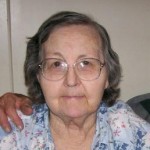
 When a person has Alzheimer’s Disease, everyone tends to feel sorry for them…or so they think. In reality, we don’t feel as sorry for the patient as we do for ourselves. The patient doesn’t seem to know that they are forgetting things, at least not after they are a little way into the progression of the disease. In fact, they truly live in an alternate reality, and sometimes it is a much nicer reality than we live in. If someone in their family has passed away, one of the others becomes that person on occasion. That’s how it is with my mother-in-law, Joann Schulenberg. Her husband, who is my father-in-law, Walt Schulenberg passed away on May 5, 2013, and yet, she talked to him night before last. Of course, she was talking to her son, my husband, Bob Schulenberg, but he like the rest of her family has adapted to her altered reality, so that night Bob became Walt…if only for a minute, because that is how long it takes for that reality to pass and he becomes Bob again. I suppose people might think that strange, but it is actually kindness. She doesn’t have to grieve. Her deceased loved ones are never gone from her. They are there in the people around her, and she is happy.
When a person has Alzheimer’s Disease, everyone tends to feel sorry for them…or so they think. In reality, we don’t feel as sorry for the patient as we do for ourselves. The patient doesn’t seem to know that they are forgetting things, at least not after they are a little way into the progression of the disease. In fact, they truly live in an alternate reality, and sometimes it is a much nicer reality than we live in. If someone in their family has passed away, one of the others becomes that person on occasion. That’s how it is with my mother-in-law, Joann Schulenberg. Her husband, who is my father-in-law, Walt Schulenberg passed away on May 5, 2013, and yet, she talked to him night before last. Of course, she was talking to her son, my husband, Bob Schulenberg, but he like the rest of her family has adapted to her altered reality, so that night Bob became Walt…if only for a minute, because that is how long it takes for that reality to pass and he becomes Bob again. I suppose people might think that strange, but it is actually kindness. She doesn’t have to grieve. Her deceased loved ones are never gone from her. They are there in the people around her, and she is happy.
My mother-in-law does not notice the passage of time, and if she does, it sometimes seems longer than it was. She might tell you that she hasn’t seen you in a year, when in reality it was the day before. Or she might say that you were just here, when you have been out of town for a week. Time is based on her own perception of it at the time, and that’s ok with me. As long as she’s happy, I’m happy.
As her birthday approached this year, I’ve been telling her that February is almost over. She doesn’t always think that is possible, and I can relate to that. Time really does fly by. So, on Saturday when I told her that her birthday was coming, she said it couldn’t be, because we hadn’t had Christmas yet. Now I would love to tell you that I had a quick come back for that one, but sometimes she catches me off guard. I told her Christmas had passed, and it was February. Thankfully she accepted that answer and the conversation moved forward. Yesterday, as we were waiting for the bus to take her back to the nursing home after he check up with the 
 doctor, I asked her what today was going to be. She didn’t know, so I told her that it was February 28th. She perked up. I asked her what that day was, and she said that it was her birthday. I was pleased at that, so I thought I would take it one step further. I asked her how old she was going to be. She didn’t know, so I suggested that she take a guess. Well, I guess that the moment of clarity was over, because she said, “I’m 50 something.” She was only 36 years off, but it doesn’t really matter anyway, because you’re only as old as you feel…right? Happy birthday Mom!! Have a great day!! We love you!!
doctor, I asked her what today was going to be. She didn’t know, so I told her that it was February 28th. She perked up. I asked her what that day was, and she said that it was her birthday. I was pleased at that, so I thought I would take it one step further. I asked her how old she was going to be. She didn’t know, so I suggested that she take a guess. Well, I guess that the moment of clarity was over, because she said, “I’m 50 something.” She was only 36 years off, but it doesn’t really matter anyway, because you’re only as old as you feel…right? Happy birthday Mom!! Have a great day!! We love you!!
 Sometimes, there are events in history that end up tied to other events in history, in one way or another. On this day, December 9, 2003, Tehran, Iran was hit by unseasonably cold temperature, that led to the deaths of 40 people from hypothermia. It is very rare to see such large groups of people die in this way at the same time, but it does happen, as seen in Tehran. Their deaths occurred when their core body temperature fell to 77 degrees Fahrenheit. So, how does this have anything to do with history beyond 2003? Well, it actually does, and not in a good way.
Sometimes, there are events in history that end up tied to other events in history, in one way or another. On this day, December 9, 2003, Tehran, Iran was hit by unseasonably cold temperature, that led to the deaths of 40 people from hypothermia. It is very rare to see such large groups of people die in this way at the same time, but it does happen, as seen in Tehran. Their deaths occurred when their core body temperature fell to 77 degrees Fahrenheit. So, how does this have anything to do with history beyond 2003? Well, it actually does, and not in a good way.
Most of us, these days, know about hypothermia. In fact, the causes and the fixes are pretty well known, but what I didn’t know before, although maybe I should have, is that the information we have on hypothermia came from the horrible experiments that the Nazis performed on the prisoners at the Dachau concentration camp during World War II. These unethical medical experiments that were carried out during the Third Reich fell into three categories. The first category consists of experiments aimed at facilitating the survival of Axis military personnel. In Dachau, physicians from the German air force and from the German Experimental Institution for Aviation conducted high-altitude experiments, using a low-pressure chamber, to determine the maximum altitude from which crews of damaged aircraft could parachute to safety. Scientists there carried out so-called freezing experiments using prisoners to find an effective treatment for hypothermia. While the findings might have been a good thing, the way the experiments were carried out was horrendous. After these experiments, most people knew that if they were  outside in frigid temperatures, they could die of hypothermia. Nevertheless, there were a few miracle situations, such as the two year old girl in Canada in 1994, who survived after her core body temperature dropped to 57 degrees Fahrenheit when she wandered away from her home in Saskatchewan.
outside in frigid temperatures, they could die of hypothermia. Nevertheless, there were a few miracle situations, such as the two year old girl in Canada in 1994, who survived after her core body temperature dropped to 57 degrees Fahrenheit when she wandered away from her home in Saskatchewan.
The second category of experimentation involved developing and testing pharmaceuticals and treatment methods for injuries and illnesses which German military and occupation personnel encountered in the field. Apparently the Nazis felt free to find ways to save their soldiers lives, at the expense of their prisoners. At the German concentration camps of Sachsenhausen, Dachau, Natzweiler, Buchenwald, and Neuengamme, prisoners were subjected to immunization compounds for the prevention and treatment of contagious diseases, including malaria, typhus, tuberculosis, typhoid fever, yellow fever, and infectious hepatitis. The Ravensbrueck camp was the site of bone-grafting experiments and experiments to test the efficacy of newly developed sulfanilamide drugs. At Natzweiler and Sachsenhausen, scientists tested prisoners with phosgene and mustard gas in order to find possible antidotes. Their lives simply didn’t matter when it came to the experimentation.
The third category of medical experimentation sought to advance the racial and ideological principles of the Nazi worldview. The most infamous were the experiments of Josef Mengele at Auschwitz. Mengele conducted medical experiments on twins. He also directed serological experiments on Roma Gypsies, as did Werner  Fischer at Sachsenhausen, in order to determine how different “races” withstood various contagious diseases. The research of August Hirt at Strasbourg University also intended to establish “Jewish racial inferiority.” Other gruesome experiments meant to further Nazi racial goals were a series of sterilization experiments, undertaken primarily at Auschwitz and Ravensbrueck. There, scientists tested a number of methods in their effort to develop an efficient and inexpensive procedure for the mass sterilization of Jews, Roma Gypsies, and other groups that the Nazi leaders considered to be racially or genetically undesirable. It is difficult for me to even think about the cruelty that the Nazis inflicted on the Jews and Gypsies during those horrible years.
Fischer at Sachsenhausen, in order to determine how different “races” withstood various contagious diseases. The research of August Hirt at Strasbourg University also intended to establish “Jewish racial inferiority.” Other gruesome experiments meant to further Nazi racial goals were a series of sterilization experiments, undertaken primarily at Auschwitz and Ravensbrueck. There, scientists tested a number of methods in their effort to develop an efficient and inexpensive procedure for the mass sterilization of Jews, Roma Gypsies, and other groups that the Nazi leaders considered to be racially or genetically undesirable. It is difficult for me to even think about the cruelty that the Nazis inflicted on the Jews and Gypsies during those horrible years.
 About a month ago, my husband Bob and I went to visit family in Forsyth, Montana. We had a wonderful time visiting, reminiscing, and learning new family information. It was a trip we needed to take, because it had been far too long since our last visit. The family there is just so important to us. We knew we couldn’t let any more time pass before we went to visit. Two of the people we wanted to spend time with, were Bob’s aunt and uncle, Eddie and Pearl Hein. Eddie recently had a couple of strokes, and we wanted to show him how important he is to us, and Pearl had been taking care of him, almost on her own, and since I have been a caregiver, I know that she needs support too, even if it is just moral support. Caregiving is exhausting work, and while the patient wishes they didn’t need you to work so hard…the fact remains that they do, and they know that without you, they would be in a nursing home, or worse. Still, caregiving
About a month ago, my husband Bob and I went to visit family in Forsyth, Montana. We had a wonderful time visiting, reminiscing, and learning new family information. It was a trip we needed to take, because it had been far too long since our last visit. The family there is just so important to us. We knew we couldn’t let any more time pass before we went to visit. Two of the people we wanted to spend time with, were Bob’s aunt and uncle, Eddie and Pearl Hein. Eddie recently had a couple of strokes, and we wanted to show him how important he is to us, and Pearl had been taking care of him, almost on her own, and since I have been a caregiver, I know that she needs support too, even if it is just moral support. Caregiving is exhausting work, and while the patient wishes they didn’t need you to work so hard…the fact remains that they do, and they know that without you, they would be in a nursing home, or worse. Still, caregiving 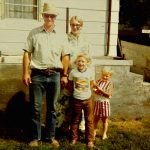 takes it’s toll on the caregiver, and I was worried about Pearl too. But Pearl loves Eddie, and she did what she had to do, and she has been rewarded with a husband who is healthy again, and getting stronger every day.
takes it’s toll on the caregiver, and I was worried about Pearl too. But Pearl loves Eddie, and she did what she had to do, and she has been rewarded with a husband who is healthy again, and getting stronger every day.
When we saw Eddie and Pearl, we were very pleased to see that they were both doing quite well. They looked a little tired, but then right now, everything they do is harder…physically harder. Eddie is in the process of re-learning how to do many things that we all take for granted every day. I didn’t know what to expect when we were getting ready to see Eddie, even though, Bob’s Uncle Butch Schulenberg had told us that Eddie was really improving. We didn’t know if Eddie could talk well, or walk well, or what. We were so relieved when Eddie walked into Butch’s house, smiling and talking clearly. We were so relieved, but we should not have been  surprised. No, we should have known that Eddie would be back, because he is a strong man, and he won’t ever give up.
surprised. No, we should have known that Eddie would be back, because he is a strong man, and he won’t ever give up.
Eddie spent most of his adult life working in the Peabody coal mine in Colstrip, Montana. He worked hard to support his family, and when he was home, he worked to renovate their home. He and Pearl have always had a garden, and worked together to grow fresh vegetables for their family. In fact, they have both worked hard all their lives. That is what has made them the strong people they are, and that is why I know that Eddie will come back from this stronger than ever. Today is Eddie’s birthday. Happy birthday Eddie!! Have a great day!! We love you!!
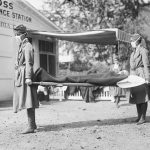
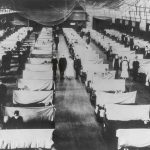 Not everyone agrees with getting the flu shot, and I get that. Still, even though there have been issues with the flu shot, it has also been something, along with medicines that has helped to prevent breakouts like the flu pandemic that hit Philadelphia on this day, September 28, 1918. It is believed that a Liberty Loan parade prompted the outbreak in Philadelphia, and before the outbreak was over, an estimated 30 million people worldwide were dead. As most of us know, influenza is a virus that attacks the respiratory system, is highly contagious, and mutates very quickly to avoid being killed by the human immune system. A prior pandemic of the flu in 1889 killed thousands all over the world, but it was nothing like the 1918 Flu Pandemic in its deadliness.
Not everyone agrees with getting the flu shot, and I get that. Still, even though there have been issues with the flu shot, it has also been something, along with medicines that has helped to prevent breakouts like the flu pandemic that hit Philadelphia on this day, September 28, 1918. It is believed that a Liberty Loan parade prompted the outbreak in Philadelphia, and before the outbreak was over, an estimated 30 million people worldwide were dead. As most of us know, influenza is a virus that attacks the respiratory system, is highly contagious, and mutates very quickly to avoid being killed by the human immune system. A prior pandemic of the flu in 1889 killed thousands all over the world, but it was nothing like the 1918 Flu Pandemic in its deadliness.
It is thought that the 1918 flu pandemic originated with a bird or farm animal in the American Midwest early that year. It may have traveled among birds, pigs, sheep, moose, bison, and elk, eventually mutating to the version that took hold in the human population that year. Like most outbreaks, this one started slowly, but as people moved from place to place, and others came in to help, it began to spread like wildfire. Once it spread to Europe later in the year, through some of the 200,000 American troops shipped out to fight in World War I, it was out of control. It affected every area of life, and people wore masks to avoid contact with the virus.
By June 1918, it had largely disappeared in North America, but only after taking a considerable toll on the people. Over the summer of 1918, it spread quickly over Europe. It’s first stop seems to have been in Spain, and it took so many lives there, that it was named the Spanish Flu. This flu was highly unusual, because it seemed to affect strong people in the prime of their lives rather than babies and the elderly. By the end of the summer, about 10,000 people were dead. In most cases, hemorrhages in the nose and lungs killed victims within three days. By fall, it was completely out of control. By the time it reached London and Boston in 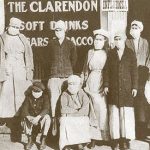
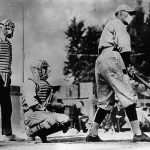 September, it was a far worse strain that it had been before. Twelve thousand soldiers came down with the flu in Massachusetts in mid-September. Philadelphia was the hardest hit city in the United States with a loss of nearly 12,000. The whole city was quarantined. In the United States, five out of every thousand people fell victim to the flu. Other countries were far worse, some as much as ten, fifteen or even thirty five per thousand, with 20 million people dying in India alone. In the end, more people died from the influenza pandemic, than from all of the battles of World War I combined.
September, it was a far worse strain that it had been before. Twelve thousand soldiers came down with the flu in Massachusetts in mid-September. Philadelphia was the hardest hit city in the United States with a loss of nearly 12,000. The whole city was quarantined. In the United States, five out of every thousand people fell victim to the flu. Other countries were far worse, some as much as ten, fifteen or even thirty five per thousand, with 20 million people dying in India alone. In the end, more people died from the influenza pandemic, than from all of the battles of World War I combined.
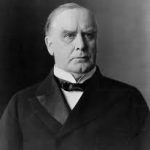 I find it very sad to think that if a person had some ailments or injuries in this day and age, they would likely have lived through the episode, but in days gone by, and for President McKinley, that was not to be the case.
I find it very sad to think that if a person had some ailments or injuries in this day and age, they would likely have lived through the episode, but in days gone by, and for President McKinley, that was not to be the case.
On September 6, 1901, while standing in a receiving line at the Pan-American Exposition in Buffalo, New York, McKinley was approached by Leon Czolgosz, a Polish-American anarchist carrying a concealed .32 revolver in a handkerchief. Czolgosz shot McKinley twice at close range. One bullet deflected off a suit button, but the other entered his stomach, passed through the kidneys, and lodged in his back. When he was operated on, doctors failed to find the bullet. That in and of itself was a very 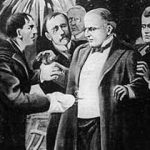 serious situation, but I believe it would have been survivable. Unfortunately for President McKinley, the doctors of that time had few, if any antibiotics to fight infection, and gangrene soon spread throughout the president’s body. McKinley died eight days later, on September 14, 1901. Czolgosz was convicted is of murder and executed soon after the shooting.
serious situation, but I believe it would have been survivable. Unfortunately for President McKinley, the doctors of that time had few, if any antibiotics to fight infection, and gangrene soon spread throughout the president’s body. McKinley died eight days later, on September 14, 1901. Czolgosz was convicted is of murder and executed soon after the shooting.
These days, there have been a number of people who have had injuries far more grave than President McKinley had, and yet they have come through with flying colors. I think it is irrelevant what a person’s politics are or whether you think President McKinley was a good president or a bad president, because this really isn’t about politics at all. The reality is that this man died largely because of a lack of modern medicines that could 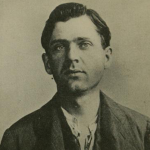 have easily cured the gangrene he had from the shooting, or in most cases, prevented it all together.
have easily cured the gangrene he had from the shooting, or in most cases, prevented it all together.
None of us likes to pay for the cost of some of the life-saving drugs that have been developed, but it is partly that cost that helps to pay for the research that goes into these new medicines. Whether we pay for them by donations before development or cost after development, really makes no difference. I know many people think that the drug companies gouge the patient, and I suppose that could be true to an extent, but which one of us has what it takes to find a medicine that cures some of the diseases we can cure today, that were a death sentence in years gone by?
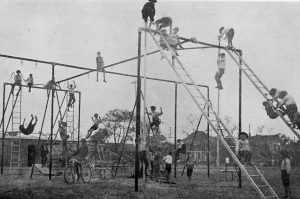
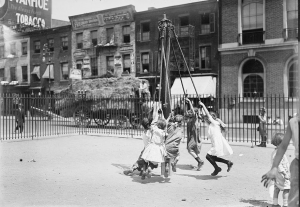 If children today were to see the playground equipment of yesteryear, I wonder if they would want to play on it, thinking it looked intriguing, or if they would simply walk away, saying that it looked boring. I suppose that to them, it probably would be boring. There weren’t any bright colored, shiny things to play on back then, and no mazes to crawl through in search of the prize…the slide at the end. I don’t know if I think that todays playground equipment is better, or worse. Or maybe, it’s just different…more advanced and inventive. I suppose that the playground equipment of earlier years required the child to be more inventive, where today’s maybe doesn’t.
If children today were to see the playground equipment of yesteryear, I wonder if they would want to play on it, thinking it looked intriguing, or if they would simply walk away, saying that it looked boring. I suppose that to them, it probably would be boring. There weren’t any bright colored, shiny things to play on back then, and no mazes to crawl through in search of the prize…the slide at the end. I don’t know if I think that todays playground equipment is better, or worse. Or maybe, it’s just different…more advanced and inventive. I suppose that the playground equipment of earlier years required the child to be more inventive, where today’s maybe doesn’t.
In the 1900s, there were often pipe built structures without paint…not that it seemed to matter to the kids. People have looked back on that equipment and wondered if it was even safe. Well, probably it wasn’t, but when you look at some of the modern day equipment, you wonder the same thing. Kids have been climbing on structures for as long as there have been kids. It’s what they do. If they have nothing to climb on or jump on, they will just jump on the bed. Now tell me you didn’t. I don’t know of one physically capable person who can honestly say they didn’t jump on the bed. In the 1900s, ladders were used to get the kids to the top of the tall structures. I’m sure that was part of the concern, but the rock climbing addition of today, isn’t really any safer, and kids will climb up the outside of a structure whether there is a proper way to get to the top or not. Remember, there isn’t a child alive who hasn’t thought at one point or another, that they were invincible.
Modern playground equipment is often designed as a “fitness” tool. That wasn’t really necessary in years gone by, because there really was no such thing as a “couch potato” then. Kids didn’t have hand held electronic gaming devises to occupy so much of their time, so they went outside and played games. I remember running around the yard until dark, once my homework was done anyway. We never sat still…and that was at home. All we had there was a swing set. The rest was make believe. The school had swings, a slide, and the monkey bars, as 
 well as tetherball poles, but no ball if school was out. Still, the school was the place to play…especially in the summer, when playing there didn’t require class time too. While the tall structure with ladders of the 1900s, or even the pole swing of 1910, looked dangerous, my guess would be that there were no more injuries on it than any other type of playground equipment…but, I could be wrong. The way I see it…kids just aren’t notoriously careful.
well as tetherball poles, but no ball if school was out. Still, the school was the place to play…especially in the summer, when playing there didn’t require class time too. While the tall structure with ladders of the 1900s, or even the pole swing of 1910, looked dangerous, my guess would be that there were no more injuries on it than any other type of playground equipment…but, I could be wrong. The way I see it…kids just aren’t notoriously careful.
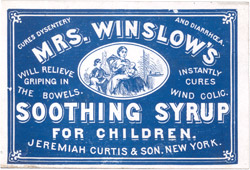 For as long as babies have been getting teeth, parents have been dealing with cranky babies. People have tried everything from a cold washcloth to alcohol. These days, there are other safe products that can be used, such as baby Tylenol, Motrin, or Ibuprofen, not to mention things like Numbs It. In years gone by, however, things were different. There were no real controls on medicines like there is today, and they didn’t know what ingredients could be harmful, or what might interact with other ingredients to cause serious problems.
For as long as babies have been getting teeth, parents have been dealing with cranky babies. People have tried everything from a cold washcloth to alcohol. These days, there are other safe products that can be used, such as baby Tylenol, Motrin, or Ibuprofen, not to mention things like Numbs It. In years gone by, however, things were different. There were no real controls on medicines like there is today, and they didn’t know what ingredients could be harmful, or what might interact with other ingredients to cause serious problems.
Inventors, and sometimes even housewives, came up with remedies that worked to ease the pain, and assumed that they had found the solution. Little did they know what problems they were causing down the road. Remedies like Doctor John’s Elixir, or some other such name, made by people with no training as a doctor, nurse, or even a pharmacist, and no control to 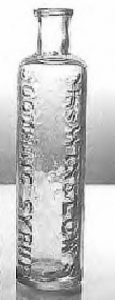 make sure they are safe. These formulas were often called “patent medicines” because they were over the counter medicines that were not patented, but were trademarked. One of the most famous was Mrs Winslow’s Soothing Syrup. In 1845, druggists Jeremiah Curtis and Benjamin A. Perkins, of Bangor, Maine, partnered to manufacture this remedy. It was said that Mrs Charlotte N Winslow, Curtis’ mother-in-law, created the formula while she was a nurse caring for infants. According to the label, the syrup could take away “teething pain, regulate the bowels, and was the best known remedy for dysentery and diarrhoea, whether arising from teething or other causes.”
make sure they are safe. These formulas were often called “patent medicines” because they were over the counter medicines that were not patented, but were trademarked. One of the most famous was Mrs Winslow’s Soothing Syrup. In 1845, druggists Jeremiah Curtis and Benjamin A. Perkins, of Bangor, Maine, partnered to manufacture this remedy. It was said that Mrs Charlotte N Winslow, Curtis’ mother-in-law, created the formula while she was a nurse caring for infants. According to the label, the syrup could take away “teething pain, regulate the bowels, and was the best known remedy for dysentery and diarrhoea, whether arising from teething or other causes.”
It all sounds wonderful…the perfect solution to all the baby’s ills, right? Wrong!! The two main ingredients were morphine and alcohol. Yes, it got rid of the pain, and pain medications cause constipation, so that took care of the other issues, but morphine is addictive at best, and deadly at worst, especially if the patient is given too much…which was a distinct possibility, given the fact that no one knew that morphine was addictive or deadly. Then add to it, alcohol…which shouldn’t be mixed with morphine, and you have a seriously dangerous drug. It’s not known exactly how many children became addicts and how many died, but it was used everywhere until it was denounced as dangerous in 1911 and even then, they still sold it until about 1930. Of course, medicines of today can be found to be dangerous, but much of the time, the medicines are tested for quite a while before they are released, and then most by prescription only…at least at first.
 My father-in-law, Walt Schulenberg would have turned 87 today. In the three years and almost four months since he went to Heaven, I can say that I have missed him very much, and yet it’s been like he never really left. Alzheimer’s Disease has taken the memory of her husband’s passing away from my mother-in-law, along with the passing of her parents and her daughter. It isn’t a bad thing for her, because she doesn’t have to experience the grief the rest of us have to go through. Nevertheless, because of her condition, I…we, the family have had to keep up the charade that Dad, Marlyce, and the Knox grandparents are still alive.
My father-in-law, Walt Schulenberg would have turned 87 today. In the three years and almost four months since he went to Heaven, I can say that I have missed him very much, and yet it’s been like he never really left. Alzheimer’s Disease has taken the memory of her husband’s passing away from my mother-in-law, along with the passing of her parents and her daughter. It isn’t a bad thing for her, because she doesn’t have to experience the grief the rest of us have to go through. Nevertheless, because of her condition, I…we, the family have had to keep up the charade that Dad, Marlyce, and the Knox grandparents are still alive.

There is a song that Tim McGraw sings about a girlfriend that broke up with her boyfriend because he wanted to move away and she didn’t. He never quite got over her, and in his imagination, he saw her in all the places he traveled. For the man in the song, I’m sure the visions were somewhat torturous, but for my mother-in-law, they are a blessing. She sees Dad in some of the men at the nursing home, in her sons and even grandsons, and she has it in her mind that he is simply in the garage, at the neighbors, or at Walmart. When she asks about him, I always tell her that he is at Walmart, and he will be back later. That satisfies her, because she knows that he would never leave her. And we know it too.
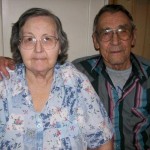 I have to wonder if Dad ever thought about all the places he would be see after he left for Heaven. We tend to think that when we pass away, we will only live on in the hearts of our loved ones, and that’s true, but the mind is a funny thing. Our imaginations can place our loved ones in places they really aren’t…whether our mind is sharp or not. There are many times I can see my mom and dad, my father-in-law, sister-in-law, and grandparents in many memories that I have filed away in my memory files, but I think that most of the time, my memories aren’t nearly a vivid as my mother-in-law’s, and that’s ok, because it allows my father-in-law to keep his promise, never to leave her, alive in my mother-in-law’s life. Happy birthday in Heaven Dad. We love and miss you very much.
I have to wonder if Dad ever thought about all the places he would be see after he left for Heaven. We tend to think that when we pass away, we will only live on in the hearts of our loved ones, and that’s true, but the mind is a funny thing. Our imaginations can place our loved ones in places they really aren’t…whether our mind is sharp or not. There are many times I can see my mom and dad, my father-in-law, sister-in-law, and grandparents in many memories that I have filed away in my memory files, but I think that most of the time, my memories aren’t nearly a vivid as my mother-in-law’s, and that’s ok, because it allows my father-in-law to keep his promise, never to leave her, alive in my mother-in-law’s life. Happy birthday in Heaven Dad. We love and miss you very much.

